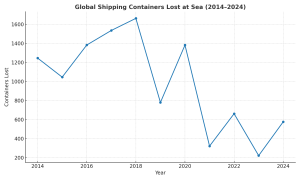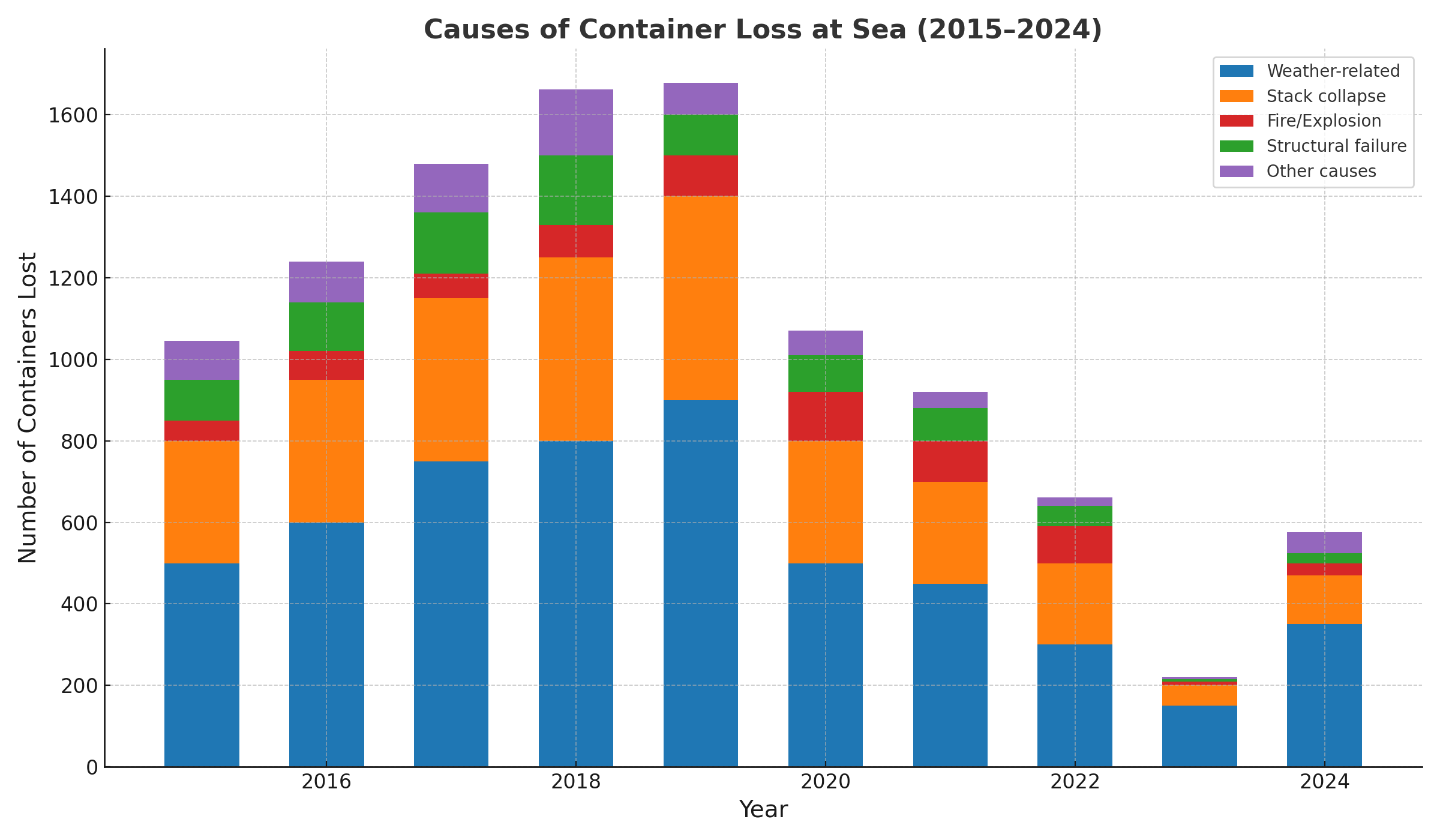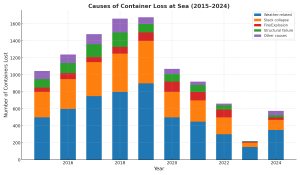The global shipping industry experienced a sharp increase in the number of containers lost at sea in 2024, according to the latest Container Loss at Sea Report released by the World Shipping Council (WSC). The report, which is a key barometer for maritime cargo safety, shows that ocean vessels lost 576 shipping containers over the past year — more than double the record-low 221 containers lost in 2023.
While the increase is significant, the numbers remain well below the 10-year annual average of 1,274 containers lost. In fact, when compared to the total global shipping volume of roughly 250 million containers transported annually, the losses account for less than 0.0002% of worldwide container movements.
This year’s findings highlight both the industry’s progress in loss prevention and the continuing challenges posed by geopolitical instability and extreme weather events.
2024 in Context: A Rebound from Record Lows
The year 2023 set a historic low for container losses, thanks to sustained safety improvements, better lashing techniques, and enhanced weather routing. However, 2024 saw a marked reversal, driven primarily by the re-routing of major shipping lanes due to conflict and security threats in the Middle East and Red Sea region.
Vessels that typically pass through the Red Sea and Suez Canal were forced to reroute around the Cape of Good Hope in South Africa — a maritime corridor infamous for volatile sea states, high winds, and the meeting of the Atlantic and Indian Oceans. According to marine tracking data, traffic in this region surged by 191% compared to previous years.
 Figure 1: Annual containers lost at sea, based on World Shipping Council data.
Figure 1: Annual containers lost at sea, based on World Shipping Council data.
Causes of Container Loss Over the Last Decade
Weather-related incidents remain the dominant factor, peaking in 2018 and 2019 during periods of intense storm activity and high seas, before declining sharply in 2023. However, 2024 saw a renewed spike due to the hazardous Cape of Good Hope route. Stack collapses — often triggered by heavy rolling in rough seas or improper weight distribution — have shown a steady downward trend thanks to better lashing technology and load planning. Fire and explosion incidents, while less frequent, have been a persistent risk tied to hazardous or undeclared cargo. Structural failures of containers or vessel fittings have become rarer with improved maintenance and design standards. The “Other causes” category captures isolated events such as collisions, grounding, or human error. Overall, the data highlight that while safety reforms have reduced most causes, extreme weather and route changes remain the most significant threats to container security at sea.
Figure 2: Causes of container loss over the last decade.
High-Risk Route: Cape of Good Hope
The South African Maritime Safety Authority (SAMSA) reported that at least 200 of the 576 containers lost in 2024 occurred in the treacherous waters off the Cape. The unique oceanographic conditions — where warm currents from the Indian Ocean collide with cold Antarctic waters — generate unpredictable and sometimes violent storms. The National Oceanic and Atmospheric Administration (NOAA) describes the region as one of the world’s most dangerous shipping passages due to its:
-
Rapidly shifting weather patterns
-
Rogue wave potential
-
Strong opposing currents
-
Limited shelter points for vessels in distress
These conditions, when coupled with heavy re-routing traffic, created the perfect storm for increased container losses.
Geopolitical Drivers of the 2024 Spike
The ongoing conflict in the Middle East, along with piracy risks and military activity in the Red Sea, forced a significant shift in global container shipping routes. While the Suez Canal typically handles around 12% of global trade, concerns over vessel safety prompted many carriers to opt for the longer and more hazardous Cape route. This detour added thousands of nautical miles to voyages between Asia, the Middle East, and Europe, exposing ships to high seas for longer durations and increasing fatigue for both vessels and crews. Longer voyages also contributed to more opportunities for cargo to shift, lashings to loosen, and stacks to collapse.
Industry Leadership Calls for Caution
Joe Kramek, President and CEO of the World Shipping Council, commented on the findings:
“This year’s report confirms that the vast majority of containers are transported safely across the oceans. Still, even one container lost is one too many. The re-routing of transits away from the Red Sea and around the Cape of Good Hope has ocean carriers navigating one of the world’s most challenging routes, as highlighted in this report.”
Kramek also underscored that the industry’s ongoing safety measures have kept losses far below historical averages despite extraordinary challenges.
Container Loss Trends: A Decade in Review
The following trends emerge from WSC data:
-
Peak Loss Years: 2018 and 2020 recorded some of the highest container loss figures in recent history, with over 1,300 containers lost in each.
-
Steady Improvements: Enhanced vessel stability calculations, stricter stacking regulations, and better meteorological forecasting have contributed to a downward trend since 2021.
-
2023 Record Low: At just 221 containers lost, 2023 set the benchmark for loss prevention.
-
2024 Rebound: The rise to 576 containers is notable but still within what WSC considers “low by historical standards.”
Safety Measures Already in Place
The WSC highlights several ongoing industry efforts to minimize losses:
-
Cargo Securing Manuals (CSMs): These documents, mandated by the International Maritime Organization (IMO), guide crew on proper securing techniques.
-
Onboard Lashing Systems: Modern vessels now feature automated tension monitoring to ensure lashings remain secure.
-
Weather Routing Services: Real-time meteorological data helps ships adjust course to avoid the worst sea conditions.
-
Stack Weight Limits: Improved compliance with weight distribution reduces the risk of stack collapse.
New Regulatory Developments
A major shift in loss prevention policy will take place in 2026, when the IMO’s mandatory container loss reporting rule comes into effect. This regulation will require all incidents of container loss to be reported, regardless of scale. The aim is to create a global database for better analysis and targeted safety interventions. In addition, WSC is promoting the Cargo Safety Program, launching in 2025, which uses AI-driven cargo screening to detect misdeclared and hazardous goods — one of the leading causes of fires on container ships.
Hazardous Cargo: A Persistent Threat
One often-overlooked factor in container loss incidents is the presence of dangerous or undeclared cargo. Such cargo can lead to shipboard fires, structural damage, and in worst-case scenarios, total vessel loss. The WSC has been at the forefront of lobbying for stricter penalties for misdeclaration. A specific win for safety advocates came in the form of new IMO rules classifying charcoal as a dangerous good, effective 2026. Many carriers are choosing to implement these changes ahead of schedule in 2025.
Economic and Environmental Impacts of Container Loss
Economic Costs
Lost containers not only represent lost cargo but also significant costs for shippers and insurers. Depending on contents, a single lost container can be valued anywhere from $50,000 to over $1 million. Large-scale loss events, like the MV Rena disaster in New Zealand in 2011, can generate claims worth hundreds of millions.
Environmental Damage
The environmental consequences of container loss can be severe:
-
Marine Pollution: Hazardous substances can leak into the ocean.
-
Navigation Hazards: Floating containers pose risks to smaller vessels and fishing boats.
-
Wildlife Impact: Non-biodegradable materials can damage ecosystems for decades.
Public Perception and Industry Reputation
While the 2024 numbers may appear alarming, maritime experts caution against misinterpreting them. Out of 250 million containers moved annually, the losses are statistically tiny. Still, high-profile incidents can damage public trust in the safety and environmental responsibility of the shipping industry. Proactive communication from industry leaders — explaining the causes, preventive measures, and statistical context — will be crucial in maintaining confidence among customers, regulators, and the public.
Looking Ahead: The Path to Fewer Losses
The WSC and its partners believe the container loss rate can be pushed even lower through:
- Greater adoption of AI-driven route optimization
- Advanced weather forecasting integration
- Real-time container movement sensors
- Stricter enforcement of cargo declaration rules
- Increased crew training for extreme weather handling
The combination of technology, regulation, and operational discipline will be key to ensuring the long-term trend continues downward.
Conclusion
The 2024 spike in container losses serves as both a warning and a testament to industry resilience. Despite rerouting through one of the most dangerous maritime corridors on earth, the losses remain a fraction of historical averages. The challenge now is to ensure that the conditions of 2024 do not become a norm — and that lessons learned translate into even safer seas in the years ahead.



Nice , thank you!